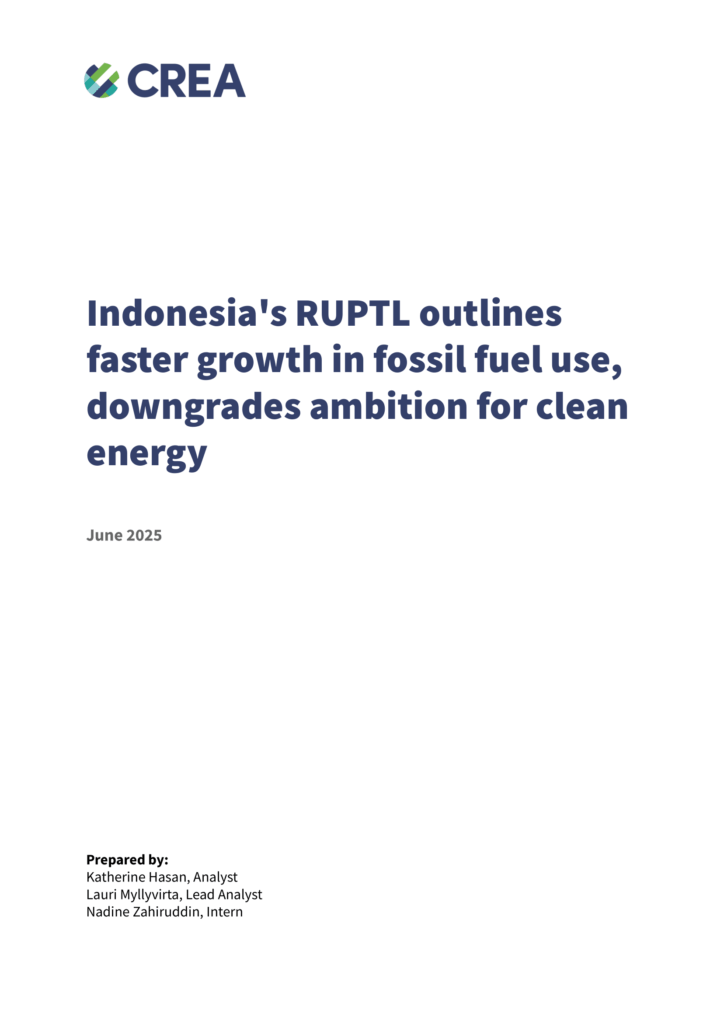🇮🇩 Versi Bahasa Indonesia tersedia di bawah
The Centre for Research on Energy and Clean Air’s (CREA) analysis on Indonesia’s recently released 10-year electricity supply plan, Rencana Umum Perencanaan Tenaga Listrik (RUPTL) 2025-2034, reveals the decision to retain sizable additions from 16.6 GW of coal and gas power and 500 MW of nuclear power in the next ten years. The plan signals a preference for a national grid system that heavily relies on fossil fuels, rather than an accelerated shift towards Indonesia’s vastly abundant renewable energy potential. President Prabowo’s vision for a phase-out of all fossil power by 2040 is not at all reflected in this plan, with no retirement schedule in sight.
Key findings
- Indonesia’s new RUPTL 2025-2034 outlines an increase of more than 40% in power generation from coal and gas from 2024 to 2034. By 2030, fossil power generation is about 10% higher than targeted in the previous RUPTL. The new plan proposes to add 16.6 GW of new fossil power through 2034, signaling a continued reliance on fossil fuels.
- Meanwhile, renewables targets have been downgraded from RUPTL 2021-2030, from 20.9 GW in new clean power capacity by 2030 to 17 GW.
- The clean energy targets in the new RUPTL fall even further short of what is laid out in the Just Energy Transition Partnership’s Comprehensive Investment and Policy Plan (JETP CIPP) released in November 2023. The RUPTL targets 10.6 GW of solar and wind by 2030 – merely 40% out of the 24.3 GW outlined in the JETP CIPP.
- Besides, coal and gas will remain dominant through the next ten years, with heavy frontloading in the first five years, reflecting President Prabowo Subianto’s recent shift from a “phase-out” fossil power by 2040 to of a “phase-down” rather than “early retirement.” The JETP CIPP’s proposed gradual coal phase-out, starting in 2025, is not adopted at all.
- The new RUPTL also increases gas power generation through 2034 by 10.3-GW, surpassing the JETP CIPP’s target by more than twice. This expansion faces a questionable and costly supply outlook, contradicting Prabowo’s vision for energy self-sufficiency and cost savings.
- Allocation of a substantial 10.3 GW of storage — 6.0 GW from Pumped Hydro Energy Storage (PHES) and 4.3 GW from battery, will naturally support the integration of 42.1 GW of planned renewables. However, strong emphasis on building storage, rather than smarter grid operation, risks prolonging fossil fuel dominance by increasing the costs and creating barriers to the energy transition.
- Achieving President Prabowo’s vision for a “fossil-free and self-sufficient energy future by 2040” requires a more aggressive shift in the RUPTL’s immediate-term plans – a clear coal retirement pathway, a robust acceleration of renewable energy deployment, particularly in the critical years of 2025-2029, and last but most importantly, PLN’s accountability in project implementation.
Figure 3. Comparison of coal power generation trajectory in the previous RUPTL 2021-2030 and the new RUPTL 2025-2034
Figure 4. Comparison of gas power generation trajectory in the previous RUPTL 2021-2030 and the new RUPTL 2025-2034
